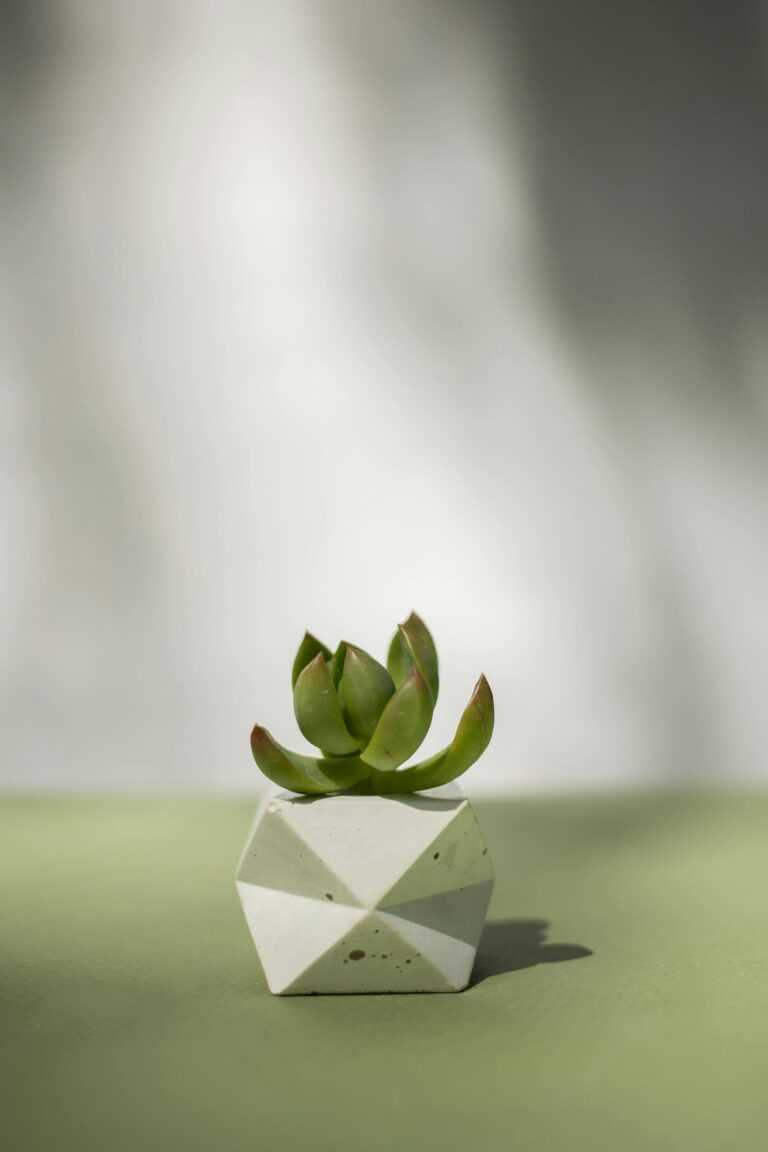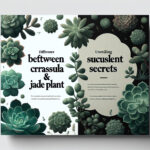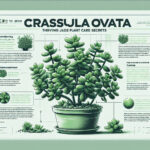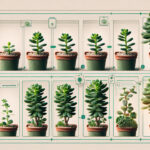Introduction to Crassula and Jade Plants
Imagine a world where plants hold mysteries, tucked in the curves of their leaves and the whispers of their names. In the realm of succulents, Crassula and Jade plants reign with a quiet elegance that often leads to a charming case of misidentity. But are these leafy characters truly one and the same? Let’s unfold the tale.
The Crassula family, hailing from far-reaching corners of the world, boasts a variety of species with fleshy, water-storing leaves that beckon to enthusiasts and casual plant-lovers alike. Among their number, we find the famed Crassula ovata, commonly and lovingly dubbed the ‘Jade plant’. This particular green celebrity is well-known for its vibrant, jade-colored leaves and sturdy, tree-like appearance.
Often found basking in the sun-drenched windows of an urban apartment or adorning the shelves of a well-curated plant shop, the term ‘Jade plant’ brings to mind the classic image of thick, glossy leaves and a resilient nature. These plants have not only etched their way into our homes but also our culture, symbolizing prosperity and luck in many societies.
As we dig a little deeper, the waters become murky. Is every Crassula a Jade plant? Or is it that every Jade plant is a Crassula? It’s a twist in the plot that plant aficionados love to explore. To ease the intrigue, it’s invaluable to consult a comprehensive care guide for the Crassula ovata. Here, the nuances of their care, the subtleties of their needs, and the secrets of their growth are laid bare.
Let’s take a moment to appreciate the visual splendor of these botanical wonders. Observe the gentle curves and robust structure of a Jade plant, sitting serenely in its earthen vessel. And here, we present a snapshot of such a storied plant – a testament to the elegance and resilience that defines our leafy subjects.

Each leaf, a palette of nature’s green, tells a story of adaptation and survival. It’s a tale that continues to captivate us, inviting a closer look at the nuanced relationship between the Crassula and the Jade plant. And as our story unfolds, we come to realize that in understanding their similarities and celebrating their differences, we unravel the tapestry of life itself.
“`html
Botanical Breakdown: Crassula Ovata and Jade Plant
When we talk about Crassula ovata and Jade Plants, we’re stepping into a horticultural hall of mirrors where things are familiar but not quite the same. It’s like comparing two vintage cars from the same manufacturer—both have the signature style, but under the hood, they’re individual marvels of engineering.

Commonly known to our green-thumbed friends as the Jade Plant, Crassula ovata is a succulent variety that has charmed its way into homes around the globe. Why? It’s robust, easy to care for, and comes with an aura of prosperity in many cultures. But delve beneath its plump, jade-colored leaves and you’ll find a botanical backstory rich with detail.
The name “Crassula” refers to the genus—a sort of family name in the plant world, while “ovata” means egg-shaped, nodding to the plant’s glossy leaves. This green guru is a bonafide member of the Crassulaceae family, a clan known for their succulent superpowers, able to store water in arid climates. Your home or office space, with its desert-dry winter air, might just be the kind of challenge Crassula ovata relishes!
If you’re thinking about adopting one of these green beauties, you’ll want to check out our insights on flourishing succulents. It’s all about giving your plants the best shot at a thriving, leafy life.
Yet, there’s still the lingering question—what about Jade Plants? In many circles, “Jade Plant” is the moniker given to Crassula ovata, but the Jade moniker can sometimes be a catch-all for multiple Crassula species and even some lookalikes from other families! It’s a bit like calling every kind of cola “Coke” – it gets the point across, but it’s not quite accurate.
The story goes deeper when you consider the habitat and conditions each plant prefers. While the Crassula ovata hails from South Africa and Mozambique, thriving on sunlight and minimal water, not all “Jade Plants” will come from the same stock or environment. Understanding these subtle differences can be the key to not just having a plant but nurturing a piece of botanical art.
“`
Visual Guide: Identifying Characteristics of Crassula and Jade
Step into the captivating world of succulents, and you’ll find the ever-popular Crassula ovata, often known by its common name, the Jade Plant. This botanical treasure has delighted plant enthusiasts with its charming, tree-like appearance and resilience. But hang on, isn’t there a chorus of “Jade” plants out there? Indeed, there is, and it’s vital to recognize the distinctive features that set the genuine Crassula ovata apart.
Let’s zero in on the true Crassula character. The Crassula ovata has thick, glossy leaves that are a vibrant green, sometimes adorned with a subtle reddish tinge along the edges, especially when basked in a sprinkle of sunlight. The shape of the leaves? Oval, plump, and they evoke the sense of prosperity, which is why they are often dubbed “Money Plant.” In blooming season, it boasts star-shaped white or pale pink flowers — a celebration on its fleshy branches.
In comparison, other “Jade” plants may possess similar plump leaves, yet often lack the lustrous sheen and defined red margins. It’s like meeting twin cousins at a family reunion; similar, yet with their own distinct style. For instance, the Portulacaria afra, commonly confused with the Crassula, showcases thinner leaves and a more limber stem.
Remember, sun exposure is Crassula’s fashion statement; with ample light, those red tips become more pronounced, giving the plant a flamboyant flair. If you’re looking to adopt one of these beauties and ensure it thrives like a green diva in your home, this comprehensive care guide is your go-to resource for all things Crassula ovata.
And here’s the showstopper, an image that encapsulates the quintessential Crassula ovata, with leaves gleaming like polished emeralds set in nature’s pot.

These identifying traits of Crassula ovata are not just markers; they’re a language spoken by the plant, telling us where it fits in the diverse world of succulents. With an eye for these details, even a novice can distinguish between the Crassula ovata and other pretenders to the Jade throne. It’s not just about putting a plant on the sill; it’s about understanding the subtle yet significant differences that make each green being in your indoor jungle a distinct personality.
Caring for Your Succulent: Tips for Both Crassula and Jade
Whether they’re perched on a sunny windowsill or adorning a bleak office, succulents like Crassula and Jade plants demand attention with their plump leaves and stately presence. It’s no wonder they’re often mistaken for one another! But here’s the secret: knowing how to pamper them properly can keep these beauties thriving. And lucky for you, they share similar spa-day needs!
First things first, let’s talk sunlight. If succulents were social media influencers, sunlight would be their currency. Both Crassula and Jade plants crave those golden rays, needing a solid four to six hours of indirect, bright light to strike that perfect pose. Place them where the sun plays peekaboo behind sheer curtains – it’s the sweet spot for their photosynthesis photoshoots!
Now, onto hydration – less is more. Imagine water as a succulent’s luxury perfume; a little spritz here and there is all you need. Overindulging can lead to soggy roots, and trust me, nobody likes wading in a swamp. A good rule of thumb is to water them when the soil feels drier than a stand-up comedian’s wit – usually every two weeks, give or take.
As for soil, think of it as the succulent’s designer gown – it has to be just right. The ideal mix is like the crumbly topping of a cherry cobbler – a well-draining blend that lets the roots breathe and sashay away from excess moisture. If you’re in the mixing mood, combine potting soil with a bit of sand or perlite for that haute couture drainage.
Feeling unsure? There’s a whole bunch of green thumbs sharing their wisdom out there. In fact, here’s a guide that dives deep into the caring tips for your succulent squad!
And hey, if you’re thirsting for more top-tier succulent smarts, don’t be shy to brush up on your knowledge with our dedicated guide to preventing your green pals from stretching towards the sun like they’re trying to snag the last cookie from the top shelf.
Remember, whether you’re nurturing a Crassula or a Jade, the key is consistency, patience, and a dash of love. With these care tips up your sleeve, your succulents will not merely survive; they’ll thrive, turning your space into a lush, leafy haven.
Common Misconceptions: Clearing Up the Confusion
In the botanical bazaar of green delights, there’s a tale as tangled as the roots of a centuries-old tree. It’s about the Crassula and the Jade plant—a story brimming with mix-ups and mistaken identities. You see, in the verdant world of succulents, these two are often mixed up like two peas in an indecipherable pod, leading many enthusiasts down a garden path of confusion. But let’s uproot those misconceptions and set the record straight.
The Crassula, with its plump, moisture-rich leaves that seem to store the very essence of life, is a succulent botanical wonder. And who hasn’t marveled at the robust Jade plant, with its deep green foliage that echoes wealth and prosperity in many cultures? They are often thought of as distant cousins at best, but here’s where the plot thickens—the Jade plant is, in fact, a member of the Crassula genus! That’s right, they’re more than just kissing cousins; they’re immediate family.
Crassula vs Jade Plant: A Botanical Whodunnit
Picturing the difference can be as clear as mud, so let me paint you a picture. Imagine walking into your friend’s lush urban jungle, only to stop dead in your tracks before a stunning display of what appears to be two distinct plant species. Yet, they are, in essence, a singular marvel of nature. The key to distinguishing between these green gems? Subtle differences in leaf shape, color, and size.
For a more vivid illustration of their similarities and differences, take a peek at this visual guide that will help set your sights on the nuances that define the Crassula and its particularly popular offshoot, the Jade plant.
To add another layer to this botanical caper, the name “Jade plant” commonly refers to Crassula ovata, a specific type that has become the poster child for this name blunder. It’s like referring to all smartphones as iPhones when we know there’s a whole spectrum of them out there.
So why does this mix-up matter, you ask? Because knowing the specifics can be crucial when nurturing these succulents back to their gloriously plump selves. Each type flourishes under slightly different conditions, and as any seasoned plant parent will tell you, the devil is in the details. Besides, isn’t it a rewarding challenge to boast of not just a green thumb but one that’s finely educated in the elegance of succulent specifics?
Let’s embrace our botanical bewilderment and transform it into a fount of knowledge that elevates our plant parenting prowess. With a bit of insight and botanical detective work, we’ll ensure that these misunderstood marvels of nature receive the care and admiration they so richly deserve. Stay tuned as we dive deeper into the leafy labyrinths of plant care and continue to debunk mystifying myths in the succulent sanctuary!
Cultural Significance and Benefits: More Than Just a Plant
When we delve into the cultural fabric of various societies, the jade plant, also known as Crassula ovata, emerges as a symbol of prosperity, luck, and renewal. This isn’t just any ordinary houseplant. For centuries, it has nestled in the heart of tradition and belief systems, particularly within Eastern cultures, where it’s often gifted as a token of good fortune during new business ventures or housewarmings. But the jade plant’s benefits extend beyond its auspicious reputation.
Imagine strolling through the bustling streets of Hong Kong, where you’ll frequently encounter jade plants proudly displayed in shop windows. This isn’t a mere design choice but a nod to an ancient belief that this emerald beauty invites financial success. In fact, during Chinese New Year, jade plants are adorned with red ribbons and lucky ornaments to amplify their energy, transforming spaces with a palpable positivity that’s almost electric to the touch.
Bringing Harmony to Home Environments
Let’s take a closer look at our own homes, where the serene presence of a jade plant can harmonize the living space. Its lush, jade-colored leaves and robust stature make it an ideal choice for those seeking to incorporate a touch of nature’s calm into the often chaotic rhythm of daily life. It’s not just about aesthetics; owning a jade plant has tangible benefits. As a natural humidifier, it contributes to a more pleasant breathing environment, which is especially beneficial during dry, cold months.
But the jade plant doesn’t stop at improving air quality. It’s also renowned for its ability to soak up electromagnetic radiation emitted by gadgets and electronics. Picture your home office, a space teeming with Wi-Fi signals and device emissions. By simply adding a jade plant to your desk, you create a guardian against this modern-day pollution, enveloping your workspace in a shield of leafy green tranquility.
The influence of jade plants on well-being is backed not only by tradition but also by empirical evidence. Studies suggest that interacting with indoor plants, like the jade or Crassula, can reduce psychological stress, giving new meaning to the term ‘living’ room. Whether it’s by tenderly caring for these succulents or simply basking in their silent company, the positive impact on mental health is undeniable.
Now, to truly appreciate the jade plant’s cultural significance and potential benefits, let’s take a moment to watch an insightful video that illuminates why this green gem deserves a place in our lives:
Whether you’re an avid gardener or someone looking to enhance their living space with a touch of verdant vitality, the jade plant stands as a beacon of nature’s enduring legacy. It represents the synergy between human culture and the botanical world, where every leaf tells a story of luck, growth, and holistic health. The Crassula isn’t just another plant; it’s a living emblem of our intertwined existence with the natural elements that sustain and enrich our lives.
Propagating Knowledge: Reproducing Your Crassula or Jade
Are you looking to expand your indoor garden with minimal effort? Look no further than the resilient Crassula ovata, commonly known as the jade plant. This succulent is as generous as it is beautiful, offering the simplest pathways to propagation. Whether you’ve got a seasoned green thumb or are just starting, propagating Crassula ovata – and by extension, many Jade-type plants – is a rewarding venture that is surprisingly straightforward. Let’s dig into the steps.
Selecting Your Succulent ‘Starters’
Begin your propagation journey by choosing healthy leaves or stem cuttings from your existing Crassula plant. Look for plump, vibrant leaves, free of spots or blemishes – these are the prime candidates for a future of lush growth. The same goes for stem cuttings; a hearty, robust stem segment can give life to multiple new plants.
The Secret to Succulent Cutting Success
After selecting your cuttings, the next step is crucial: let them callous. This means allowing the cut end to dry out and harden, which typically takes a few days. Patience is paramount here, as a well-calloused cutting shields against rot, setting the stage for a successful propagation.
Rooting Your Jade’s Future
Once calloused, place your cuttings on top of a well-draining soil mix specifically formulated for succulents. This environment encourages the cutting to focus its energy on rooting. Mist the soil lightly to provide some moisture, but not so much that it becomes soggy – jade plants prefer their living space on the drier side, after all.
Let There Be Light…But Not Too Much
Crassula ovata thrives in bright, indirect light. Position your prospective propagations in a spot that’s bathed in gentle morning sunlight or soft afternoon rays. Avoid the intense midday sun, as it can be too harsh for the delicate new roots and leaves.
Within weeks, you’ll notice the magical emergence of tiny roots, and not long after, new shoots. It’s an almost effortless process, yet infinitely gratifying. Soon, you’ll have new jade plants to nurture or share with friends, a testament to the simplicity and beauty of nature’s design.
Incorporating real-life examples, just like Laura from the sunny suburbs of Florida who successfully propagated over twenty jade plants on her breezy windowsill. Or like Tom, the city-dweller, who transformed his high-rise apartment into a jungle oasis, all starting with a single Jade cutting from his grandmother’s old plant.
Watch and learn from experts in this engaging video, which encapsulates the wonder of propagating your own Crassula ovata:
Is Crassula the same as Jade? They might as well be when it comes to reproduction – both plants share a simplicity that makes growing your collection, or starting it, a breeze. Whether you view this as a fun project or a passionate pursuit of greenery, one thing is sure – your efforts will take root and flourish, just like the Crassula ovata itself.
The Verdict: Is Crassula Really a Jade Plant?
You’ve likely seen these lush, rubbery beauties perched on window sills and at cozy corners of offices or homes, their plump leaves glistening as if freshly polished. The question at hand is simple yet has perplexed many: Is the Crassula plant the same as the well-loved Jade plant? Let’s dive in and untangle this botanical conundrum!
Crassula, the genus boasting a wide variety of species including the popular Crassula ovata, is often used interchangeably with the term ‘Jade Plant.’ However, this is where the mix-up begins. Think of Crassula as the big family name, and within this family, you’ve got your VIP member, the Crassula ovata, commonly referred to as the Jade Plant. This star of the family is the one that’s captured the hearts of plant enthusiasts worldwide with its vibrant, jade-colored leaves and robust growth.
Let’s clear the air with a real-life example. Imagine going to a family reunion where everyone shares the last name ‘Smith.’ Now, among the Smiths is John, who’s known for his incredible storytelling. When someone mentions ‘The Storytelling Smith’, they’re specifically referring to John, not the entire Smith family. Similarly, when someone calls a plant a Jade Plant, they’re specifically talking about the Crassula ovata, and not any Crassula species.
Now, feast your eyes on this: The Crassula ovata in its full glory. Here’s a video to walk you through why this particular Crassula is the superstar and rightfully deserves the ‘Jade’ title.
So, while all Jades are Crassulas, not all Crassulas are Jades. It’s an exclusive club, and the Crassula ovata is the one wearing the Jade badge. This distinction is crucial for anyone looking to delve into the world of succulents, where precision can be the difference between a thriving plant and a gardening misstep.
Wrapping our heads around this, it’s evident that, indeed, when we speak of the Jade Plant, we are specifically singing praises to the Crassula ovata. Its resilience, ease of care, and aesthetic appeal make it an undeniable favourite. In the grand tapestry of succulents, the Jade Plant shines through, a treasure amidst the verdant sea of Crassulas.
Frequently Asked Questions
Are you tangled in the leaves of gardening jargon, trying to figure out if a Crassula is the same as a Jade plant? Let’s prune through the confusion together in a way that’s as refreshing as a spritz of water on a sunny day.
Is Crassula the Same as a Jade Plant?
Imagine stepping into a friend’s lush greenhouse, admiring their plump, glossy green plants, and you exclaim, “What lovely Crassulas you have!” Only to hear them gently correct you, “Ah, those are actually Jade plants, my dear.” Now, you’re both right and wrong at the same time, because while all Jade plants are Crassulas, not all Crassulas are Jade plants. It’s like squares and rectangles – a square is always a rectangle, but a rectangle isn’t always a square. Jade plant refers specifically to Crassula ovata, the plant’s poster child, while ‘Crassula’ is a whole family of succulents with a diverse guest list!
How Can I Tell Them Apart?
The Crassula family reunion is a hoot, with over 1,400 species milling about. To spot a true Jade plant, look for fleshy, oval-shaped leaves with a rich jade green color. It’s like a plant version of spotting a celebrity at a gala. If the leaves are a little too quirky or the shape just doesn’t jive, you’re likely looking at one of Jade’s kin, perhaps a ‘Crassula arborescens’ with its silvery sheen, or a ‘Crassula tetragona’ stretching up like a mini pine tree.
Caring for Your Succulent Stars
Think of caring for your Crassula or Jade as you would nurturing a blossoming friendship. They need a bright, sunny corner in your life (or home), just enough water to keep them plump without soggy feet, and a little whisper of encouragement now and then. Just like a friend, they’ll thrive with the right balance of attention and space to grow. Overwatering is the equivalent of over-texting – a surefire way to make things awkward and wilted.
For a visual guide on how to distinguish and care for your Crassula and Jade plants, take a look at this informative video:
Green thumb or Not – Can I Grow One?
Whether you’re the type who nurtures your plants with a daily pep talk or the type who’s surprised when the cactus survives, Crassulas and Jades are forgiving friends. They’re the perfect starter plants, bouncing back from neglect with the resilience of a soap opera protagonist. Give it a shot, and you might just find your inner horticulturist humming with joy!
Any Parting Tips?
While I won’t leave you with a farewell handshake, I’ll offer a quick tip – propagation! It’s like getting your plant to clone its most charismatic traits. Snip a leaf or a stem, let it callous like a seasoned traveler’s feet, and plop it in some soil. In no time, you’ll have baby Crassulas spreading joy (and maybe a tad of envy) throughout your home or garden.
Stay curious, stay green, and always remember that with Crassulas and Jades, you’re not just growing plants; you’re cultivating a living art piece and a story to share with every new sprout!



